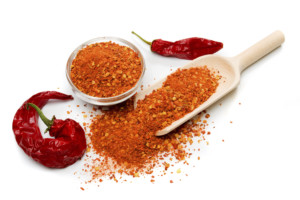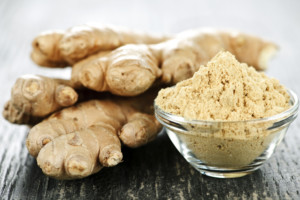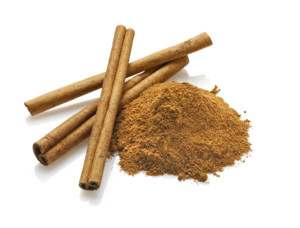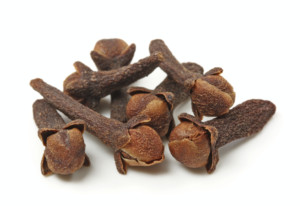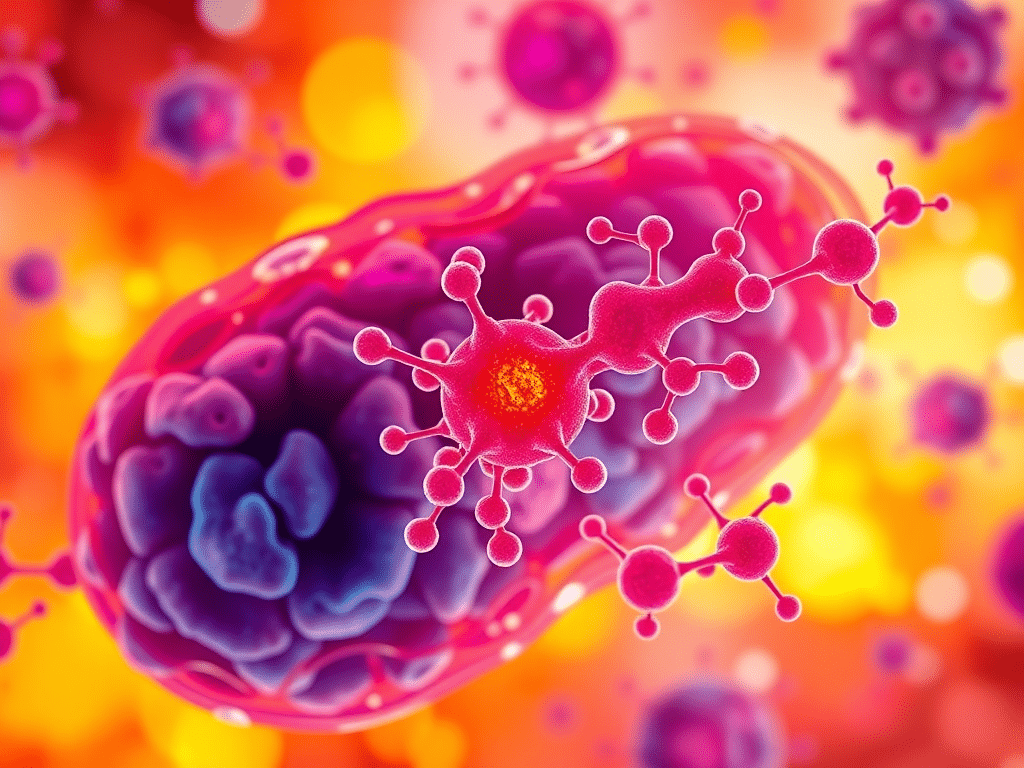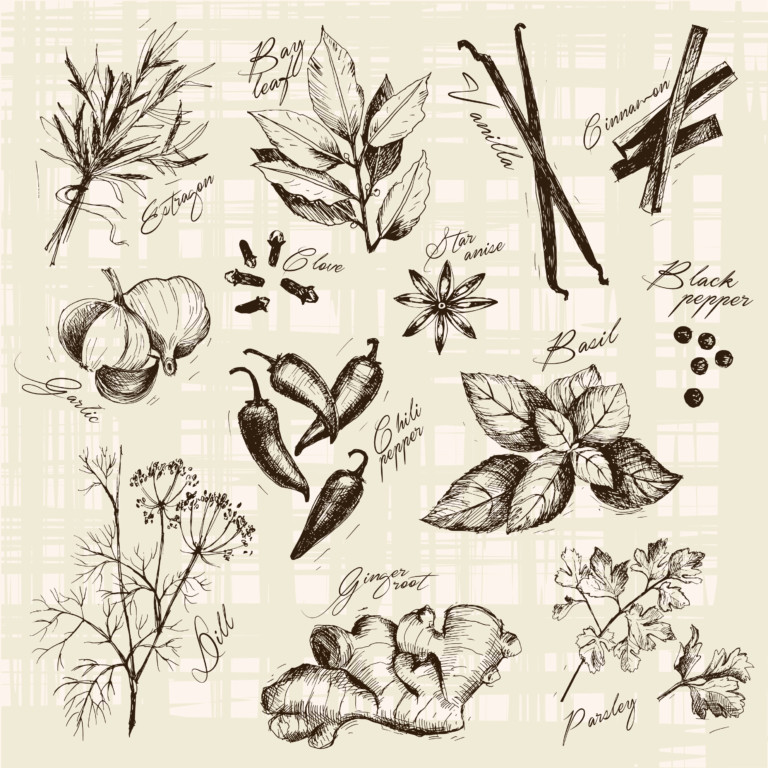
Most herbs and spices are good for you and antioxidant function. It’s also common for them to improve your gut flora, but which are the best?
The arrangement of herbs, spices, and other flavorings in The Bulletproof Diet Roadmap (download the roadmap free here) is designed to help you maximize the performance benefits of spices, minimize antinutrient exposure, and keep you firmly in charge of your own biology.
The Bulletproof Diet helps you to heal your gut by eating anti-inflammatory foods that also are delicious and satisfying. Many chronic diseases result from inflammation on the cellular level or in one or more (or all) body systems. Reducing inflammation to ideal levels is key to achieving optimal functioning, enhanced immunity, vibrant energy, mental clarity, and all the other things that give you the kind of energy you want to have all day.
It’s not just spices – other foods have anti-inflammatory properties, chief among them vegetables – especially dark-colored greens and cruciferous veggies like broccoli and cabbage. Omega-3-rich fish, egg yolks, and grass-fed meats are anti-inflammatory sources too.
But spices and herbs deserve a special consideration because, on an ounce per ounce basis, herbs and spices are extremely potent compared to other foods; adding a few carefully preserved herbs to your food can amplify the antioxidant power of your meal, and taste good too. That’s why they’re in The Bulletproof Diet.
This post lays out the top 7 herbs and spices and why they work so well for your body and mind. TLDR? They are:
- Turmeric
- Cayenne
- Ginger
- Cinnamon
- Cloves
- Sage
- Rosemary
One herb you’d expect to find on the list, but won’t, is black pepper. Read on to learn why!
How Herbs and Spices Reduce Inflammation In Your Body
Chinese and Ayurvedic medical practitioners have used herbs and spices to treat all manner of ailments, thanks in large part to their anti-inflammatory and antioxidant properties, and probably due to changes they cause in the gut biome.
Inflammation and oxidation are closely related: antioxidants quell free radicals that damage cells and lead to inflammation. Nutrients can also prevent inflammation through other pathways, notably by turning off genes that trigger inflammatory proteins or processes, by boosting the concentration of proteins that counter inflammation, or modulating the gut biome.
This power is highly concentrated in herbs and spices; just half a teaspoon of ground cinnamon has as many antioxidants as half a cup of blueberries, and half a teaspoon of dried oregano has the antioxidant power of three cups of raw spinach.[1]
-
Turmeric
If ever a spice were life-enhancing, turmeric is it.
Used for centuries in Indian (Ayurvedic) and Chinese medicine for everything from liver disease to arthritis to immune disorders, rigorous scientific studies in recent decades confirm that turmeric has “antioxidant, anti-inflammatory, antiviral, antibacterial, antifungal, and anticancer activities and thus has a potential against various malignant diseases, diabetes, allergies, arthritis, Alzheimer’s disease, and other chronic illnesses[ii]”. In other words: find yourself a good curry recipe and live out your life in optimal health. Well, sort of…
Turmeric’s benefits are largely pinned to curcumin, a potent antioxidant that dramatically reduces inflammation (while also giving the spice its vibrant yellow color). Curcumin inhibits the growth of tumor cells in a variety of cancers and improves insulin resistance in subjects with altered metabolic function[iii]. It’s bioavailability is low and increases dramatically when taken with black pepper (extract [iv].
That’s why some turmeric capsules are packed with bioperine, an extract of black pepper. However, the easiest way to raise blood concentrations of something is to inhibit liver enzymes, which isn’t necessarily a good thing. I don’t use black pepper extracts for that reason; there are better ways to increase absorption of turmeric, like using BCM-95, a standardized extract of turmeric oils that is proven to absorb well without the unforeseen effects of black pepper. (That said, black pepper itself has some interesting properties, but it’s very hard to find it without aflatoxin, the most potent mycotoxin, which is why I’ve found it to be worth treating as a suspect food.)
But the story doesn’t end with curcumin. Turmeric contains two dozen other anti-inflammatory compounds, including six different COX-2 inhibitors (the COX-2 enzyme speeds up the formation of substances that cause inflammation and pain, and causes tumor cells to grow) [v].
Turmeric also blocks the formation of the beta-amyloid plaques that cause Alzheimer’s disease, in part by turning off the NF-kappa B family of molecules that trigger inflammatory proteins uncontrollably during stress[vi].
Include turmeric in your diet by adding it to salad dressings and meat or fish marinades, or by making a turmeric-infused tea or latte.
-
Cayenne Pepper
Capsaicin is the compound responsible for both the medicinal properties of cayenne pepper and its spicy taste. The hotter the pepper, the more capsaicin it contains. It’s used widely in ointments and creams as a pain-relief aid because it depletes nerve cells of substance P, a chemical that transmits pain signals to the brain[vii]. (You can learn a lot about substance P and inflammation in the Bulletproof Radio show with Dr. Jennings #179…)
Native Americans used cayenne as a food and medicine for thousands of years, and the spice has been used widely by healers in India, China, and other parts of Asia for centuries to relieve digestive and circulatory problems[viii].
Warning: cayenne is a member of the nightshade family, and you may be sensitive to it. It is also almost as likely as black pepper to have high amounts of mold toxins in it. Quality matters, and storage conditions matter greatly for this spice.
Cayenne contains a range of flavonoids and carotenoids – antioxidants that scavenge free radicals to protect against the cellular damage that leads to inflammation and disease[ix]. Research is underway now to determine whether cayenne can prevent or slow cancer cell growth, and some studies suggest the spice can prevent prostate cancer; however, the science here is young and some results are contradictory[x].
Cayenne may also promote weight loss by raising core body and skin temperature, thus inducing greater energy expenditure[xi]. There’s even a study showing that if you mix it with XCT or Brain Octane as a carrier, it can increase thermogenesis over either one used alone![xi]
-
Ginger
Ginger is another spice that’s been used for centuries for inflammation and pain, to soothe sore muscles and throats, and combat general aches and fatigue. Ginger attacks inflammation through the action of gingerols, shogaols, and paradols.
The potent antioxidant 6-gingerol inhibits production of the free radical peroxynitrite that causes inflammation and pain[xii]. (Overgrowth of gut bacteria is linked with excessive peroxynitrite.) As a group these ginger compounds act like non-steroidal anti-inflammatory drugs (NSAIDS) (e.g., ibuprofen, Aleve, Celebrex) used widely in this country to relieve arthritis pain. But why turn to drugs when ginger blocks the pain-causing chemicals associated with arthritis? Systematic reviews of clinical trials confirm the effect of ginger in relieving osteoarthritic pain[xiii].
It goes well in Asian dishes (and really anything, if you like the kick), it’s great added to tea for a sore throat or cold, and it’s effective in fresh and powdered form. Ginger is easy to use in foods, but you can even apply it directly to a painful joint for relief. The component 6-shogaol has an effect similar to that of capsaicin (the active component of chili peppers) on the neuropeptide substance P, which sends pain signals to the brain[xiv].
Low quality or poorly stored ginger powder is at high risk for mycotoxin, and fresh ginger molds easily in the fridge. There are documented immunosuppressant mycotoxins in some ginger molds and it was described as “heavily contaminated” in another survey of spices – so get the fresh stuff, or store the dry stuff away from heat, moisture, and light.
Hint for cooking: if you cook ginger in fat, it tends to get bitter. Adding it towards the end of cooking with oil preserves flavors better!
Hint for sushi: All sushi ginger has sugar in it, but if your sushi ginger is pink, it also contains artificial dye. Only eat the yellow version, and not a lot unless you want the sugar.
Hint for joint wraps: peel and mince 1-2 Tbsps. of ginger and mix with enough XCT oil to form a paste. Warm the paste and apply to joint for 10-15 minutes with or without a wrap.
-
Cinnamon
Cinnamon’s claim to fame is its ability to lower blood sugar in diabetics by activating insulin receptors[xv]. Like many other herbs and spices, cinnamon also has a host of compounds with antioxidant and anti-inflammatory properties that can lessen the likelihood of cellular damage and chronic disease.
Cinnamaldehyde inhibits the NF-kappaB proteins, transcription factors for pro-inflammatory genes and genes involved in immune, growth, and cell death responses, and it prevents blood platelets from clumping – all of which protect against heart disease, among other diseases of inflammation[xvi],[xvii].
Cinnamon also blocks growth factors associated with abnormal cell growth, thus protecting against cancer[xviii].
-
Cloves
Cloves contain eugenol, a compound similar to but more potent than cinnamon’s cinnamaldehye[xix], and thus the spice also protects against the inflammation that underlies heart disease, cancer, and the other chronic diseases that plague eaters of the typical American diet.
Eugenol works in part by blocking the COX-2 enzyme that causes inflammation (and which, if you recall, is the target for NSAIDS). Cloves are extremely rich in antioxidants, including the flavonoids kaempferol and rhamnetin[xx].
Their free-radical scavenging power is actually greater than that of the synthetic antioxidant compounds butylated hydroxyanisole (BHA) and butylated hydroxytoluene (BHT) used as food preservatives (despite being likely human carcinogens). Cloves pop up in autumnal recipes, like mulled wine and poached fruit, and whole cloves can be ground to add to spice mixtures for meats and other dishes.
Cloves are also powerfully antifungal in the body and applied locally, but clove oil is so strong it can be toxic if overused.
-
Sage
Carnosic acid and carnosol are the chief anti-inflammatory molecules that give sage its health benefits and contribute to its flavor/aroma. Sage is studied for its protective effect against inflammation-based neurological conditions like Alzheimer’s[xxi].
The herb also shows promise for improving memory and concentration, and lessening anxiety. Carnosic acid and carnosol also have antioxidant and anticancer effects[xxii].
Camphor, another sage constituent, kills bacteria and fungi, and still other sage-derived compounds are effective antivirals. In the kitchen, sage goes well with winter squash, in sausages, and with meat roasts.
There are tons of species of sage, so you may find a difference in flavor between types. One relative of the culinary sage is salvia divinorum, a potent hallucinogen!
-
Rosemary
Rosemary contains some of the same antioxidant and anti-inflammatory compounds as sage, and yet another that’s appropriately named “rosmarinic acid”.
Both rosemary and sage act by increasing the activity of superoxide dismutase, an enzyme that removes superoxide, the potent free radical that’s associated with chronic inflammation[xxiii]. This activity is greatest for the cooked herb, so use rosemary to flavor roasted vegetables, meats, or other cooked dishes[xxiv].
You can also benefit from the uncooked herb, as rosemary’s flavonoids are many and miraculous. They include apigenin, a compound that can inhibit the growth of pancreatic cancer cells, and diosmin, which prevents hemorrhoids.
Like many anti-inflammatory agents, these work by inhibiting synthesis of prostaglandins, the proteins that trigger widespread inflammation.
Hint: If you’re going to cook something in oil (saute or fry or broil), add some rosemary to the oil to allow its antioxidants to help preserve the oil from oxidation.
How To Avoid Mold Toxins in Spices and Herbs
You won’t be surprised to learn that mold toxins are found not just in coffee and food, but in spices and herbs too. The Bulletproof Diet book details how and why this happens, and all the best practices to pick the best spices and herbs.
The herb and spice industry is painfully aware of spoilage issues, which is why it’s become so common to irradiate spices.
This process exposes them to radiation so they become sterilized. Irradiation may destroy some of the anti-oxidant and health benefits of herbs and spices, and irradiated or not, herbs and spices can spoil easily in your own home. Herbs often contain naturally strong antifungal and antibacterial oils, so the species that can flourish on them are usually the most aggressive toxin-formers.
When you get that canister of paprika down from the back shelf, pry it open, and dump some into a steaming pot of food, you’re likely putting a substantial amount of toxin in, too, because the *last* time you did that, the steam entered the paprika package and started the mold growing. You’ll always find a few mold spores in natural products, and the environment in your spice cabinet above the stove is a perfect incubator.
This means it is critical to select your source accordingly:
- One of the simplest things you can do to increase your performance is to toss out opened, dried spices that are more than a few months old.
- Use high-quality, recently opened, fresh or dried herbs and spices, or don’t use them at all.
- I’ve done my best to identify the rationale behind the spice rankings in the Bulletproof Diet Roadmap but there is always room for personal experimentation. Black pepper is so commonly contaminated that I moved it into the suspect zone! It’s up to you to decide where you go on the roadmap and how that makes you feel and perform.
If you’re eating an anti-inflammatory diet and not including ample amounts of spices and herbs, you’re missing out!
These top inflammation fighting herbs and spices will make your Bulletproof meals even more healthy and delicious.
Read More:
- Download the free Bulletproof Diet Roadmap to learn which spices and flavorings are in the Bulletproof Zone, suspect zone, and kryptonite zone.
- Sign up to be the first to learn when Bulletproof’s new documentary on mold toxins, MOLDY, is released.
References:
[expand title=”Click to read the complete list of references.” swaptitle=”Click to hide references.”]
[i] Schrock, Karen (2010, May 30). The hidden health power of spices and herbs is revealed in recent studies. Scientific American Blogs. http://blogs.scientificamerican.com/observations/2010/05/30/the-hidden-health-power-of-spices-and-herbs-is-revealed-in-recent-studies/
[ii] Aggarwal BB, Sundaram C, Malani N, Ichikawa H. Curcumin: the Indian solid gold. Adv Exp Med Biol. 2007;595:1-75 http://www.ncbi.nlm.nih.gov/pubmed/17569205
[iii] Memorial Sloan Kettering Cancer Center Integrative Medicine Database: Herbs, Botanicals, and Other Products: Turmeric http://www.mskcc.org/cancer-care/herb/turmeric
[iv] Bastyr University Health Services: Recipes: Turmeric Anti-Inflammation Drink http://www.bastyr.edu/recipes/turmeric-anti-inflammation-drink
[v] Aggarwal BB, Sundaram C, Malani N, Ichikawa H. Curcumin: the Indian solid gold. Adv Exp Med Biol. 2007;595:1-75 http://www.ncbi.nlm.nih.gov/pubmed/17569205
[vi] Aggarwal BB, Sundaram C, Malani N, Ichikawa H. Curcumin: the Indian solid gold. Adv Exp Med Biol. 2007;595:1-75 http://www.ncbi.nlm.nih.gov/pubmed/17569205
[vii] Memorial Sloan Kettering Cancer Center Integrative Medicine Database: Herbs, Botanicals, and Other Products: Cayenne http://www.mskcc.org/cancer-care/herb/cayenne
[viii] University of Maryland Medical Center: Medical Reference Guide: Herbs: Cayenne http://umm.edu/health/medical/altmed/herb/cayenne
[ix] Srinivasan K. Biological Activities of Red Pepper (Capsicum annuum) and Its Pungent Principle Capsaicin: A Review. Crit Rev Food Sci Nutr. 2015 February. http://www.ncbi.nlm.nih.gov/pubmed/25675368
[x] Memorial Sloan Kettering Cancer Center Integrative Medicine Database: Herbs, Botanicals, and Other Products: Cayenne http://www.mskcc.org/cancer-care/herb/cayenne
[xi] Memorial Sloan Kettering Cancer Center Integrative Medicine Database: Herbs, Botanicals, and Other Products: Cayenne http://www.mskcc.org/cancer-care/herb/cayenne
[xii] Surh, Young-Joon. Anti-tumor promoting potential of selected spice ingredients with antioxidative and anti-inflammatory activities: a short review. Food and Chemical Toxicology. Aug 2002; 40(8):1091-1097. http://www.sciencedirect.com/science/article/pii/S0278691502000376
[xiii] Terry R, Posadzki P, Watson LK, et al. The use of ginger (Zingiber officinale) for the treatment of pain: a systematic review of clinical trials. Pain Med. Dec 2011; 12(12):1808-1818. http://www.ncbi.nlm.nih.gov/pubmed/22054010
[xiv] Onogi T1, Minami M, Kuraishi Y, Satoh M. Capsaicin-like effect of (6)-shogaol on substance P-containing primary afferents of rats: a possible mechanism of its analgesic action. Neuropharmacology. 1992 Nov;31(11):1165-9. http://www.ncbi.nlm.nih.gov/pubmed/1282221
[xv] Memorial Sloan Kettering Cancer Center Integrative Medicine Database: Herbs, Botanicals, and Other Products: Cinnamon http://www.mskcc.org/cancer-care/herb/cinnamon
[xvi] Memorial Sloan Kettering Cancer Center Integrative Medicine Database: Herbs, Botanicals, and Other Products: Cinnamon http://www.mskcc.org/cancer-care/herb/cinnamon
[xvii] Lawrence, Toby. The Nuclear Factor NF-?B Pathway in Inflammation. Cold Spring Harb Perspect Biol. 2009 Dec; 1(6). http://www.ncbi.nlm.nih.gov/pmc/articles/PMC2882124/
[xviii] Memorial Sloan Kettering Cancer Center Integrative Medicine Database: Herbs, Botanicals, and Other Products: Cinnamon http://www.mskcc.org/cancer-care/herb/cinnamon
[xix] Usta J, Kreydiyyeh S, Barnabe P, Bou-Moughlabay Y, Nakkash-Chmaisse H. Comparative study on the effect of cinnamon and clove extracts and their main components on different types of ATPases. Hum Exp Toxicol. 2003 Jul;22(7):355-62. http://www.ncbi.nlm.nih.gov/pubmed/12929725
[xx] Nassar, M.I. et al. Chemical Constituents of Clove (Syzygium aromaticum, Fam.
Myrtaceae) and their Antioxidant Activity. Rev Latinoamer Quím. Oct 2007.
[xxi] Clinical Trial: “Effects of Sage on Memory and Mental Performance in Alzheimer’s Disease Patients” sponsored by Oregon Health and Science University in collaboration with the National Center for Complementary and Integrative Health (NCCIH) https://clinicaltrials.gov/ct2/show/NCT00110552
[xxii] Oh, J. et al. Syk/Src pathway-targeted inhibition of skin inflammatory responses by carnosic acid. Mediators Inflamm. Apr 2012. http://www.ncbi.nlm.nih.gov/pubmed/22577255
[xxiii] Chonan, M. Springerplus. Determination of superoxide dismutase mimetic activity in common culinary herbs. Springerplus. 2014 Oct 1;3:578 http://www.ncbi.nlm.nih.gov/pubmed/25332878
[xxiv] Chonan, M. Springerplus. Determination of superoxide dismutase mimetic activity in common culinary herbs. Springerplus. 2014 Oct 1;3:578 http://www.ncbi.nlm.nih.gov/pubmed/25332878
[/expand]

